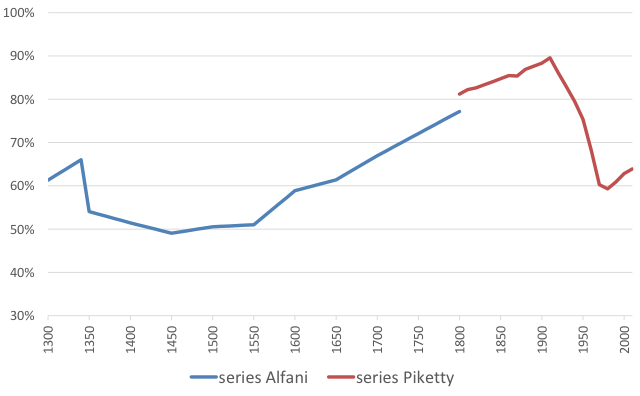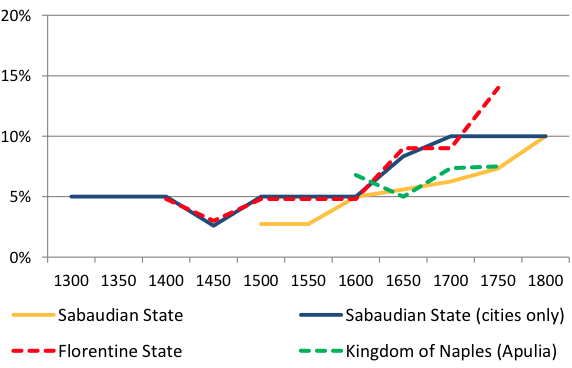Europe’s Rich Since 1300 – Analysis
By VoxEU.org
Recent research into the share of wealth owned by the richest households has given us important insights into trends in inequality. This column shows how we can now estimate the share of wealth owned by the richest households in Europe, and how many they numbered, from 1300 to the present day. Throughout this time, the only significant declines in inequality were the result of the Black Death and the World Wars.
By Guido Alfani*
n the renewed interest in long-term trends in economic inequality, particular attention has been paid to the share of income or wealth earned or owned by the top 1%, 5%, or 10%. The share of the richest is both interesting on its own terms (it shows us how ‘rich’ better-off people actually were), and as an indicator of the overall trends in economic inequality.
There is considerable evidence that the trend in the share that the richest earn or own determines the trend in general economic inequality, for example as it is measured by Gini indexes (Atkinson et al. 2011, Alvaredo et al. 2013, Roine and Waldenström 2015). New time series of wealth concentration spanning the 20th and part of the 19th century have recently been produced for some countries (Piketty et al. 2006, Piketty 2014, Roine and Waldenström 2015). This has considerably increased our knowledge of how wealth inequality has changed over time, and in the share of the richest. This research has supplemented existing studies which had covered a few countries or areas only, particularly the UK (Williamson 1985) and the US (Williamson and Lindert 1980).
Now we have comparable data for the preindustrial period. To a significant degree this is due to the ERC-funded project Economic Inequality across Italy and Europe, 1300-1800 (EINITE) (www.dondena.unibocconi.it/EINITE). EINITE has collected, systematically and with a uniform methodology, information about long-term trends in wealth inequality, and in the share of the richest, for many ancient Italian states as well as for a few other areas of Europe (Alfani 2015 and 2017, Alfani and Ryckbosch 2016, Alfani and Ammannati 2017). Whenever possible EINITE’s statistics cover the period from around 1300 to 1800, and so they allow us to extend the series of the share of wealth owned by the richest by about 500 years. Figure 1 shows the share of wealth of the top 10% between 1300 and 2010, using Piketty (2014) for the post-1800 period.
Figure 1 The share of wealth of the richest 10% in Europe, 1300-2010

Extending the Kuznets curve
Although the data used for the pre- and post-1800 periods relate to different areas of Europe, there is nevertheless an impressive apparent continuity in the series. Piketty (2014) estimated that in 1810, the richest 10% of Europeans owned 82% of the wealth. In a recent comparative article I found that, in a variety of Italian pre-unification states in 1800 the share owned by the top 10% was between 70% and 80%. The estimated average in Figure 1 is 77%.
Remarkably, Piketty’s series for 1810-1910 shows the share of the richest growing at almost exactly the same pace as the I calculated for the series between 1550 and 1800. The empirical data therefore strongly supports the view that the left-hand portion of the ‘Kuznets curve’ – an inverted-U path followed by economic inequality through the industrialisation process – can be extended to the left by many centuries (Van Zanden 1995, Alfani 2015). We can make this claim even though the underlying causes of the increase in inequality are complex and will need further research to be identified correctly (Alfani and Ryckbosch 2016, Alfani and Ammannati 2017).
In the seven centuries recent research covers, across all the territories for which we have data, we find only two phases of significant inequality decline. Both were triggered by catastrophic events:
- The Black Death, the most terrible epidemic in human history, affected Europe in 1347-51. Afterwards the richest 10% lost their grip on between 15% and 20% of overall wealth. This was a long-lasting decline in inequality. The richest 10% recovered their pre-Black Death quota only in the second half of the 17th century). This decline in the share of the top rich, as well as in overall inequality, was probably the consequence of two main factors. On one side of the distribution there was an increase in real wages of skilled and unskilled workers. We have evidence for this in many areas of Europe, as described in Pamuk (2007). This helped a larger proportion of the population to gain access to property. On the other side, large patrimonies fragmented due to a mortality crisis which was occurring in the presence of an unmitigated partible inheritance system (Alfani 2010 and 2015).
- Shocks occurred between 1915 and 1945 related to the two World Wars, as argued by Piketty 2014, pp. 368-370). The share of wealth owned by the top rich has been growing again since around 1950, and reached 64% in 2010, but it is still far from the peak of 90% reached in 1910. The share of the richest 10% today is about the same as that in Europe (or at least, Italy) immediately before the Black Death.
Additional research would substantiate these empirical similarities. One thing is clear, though: the long-term perspective of recent research requires us to move beyond the characterisation of inequality time dynamics provided by Kuznets. Milanovic (2016) recently argued that long-term trends in inequality could better be described as a succession of Kuznetsian ‘waves’, while Scheidel (2017) proposed that we generalise to an even longer period of human history the levelling ability of epidemic- and war-induced mass mortality. We need more research and more encompassing databases, especially for the preindustrial period, to assess confidently the characteristics, causes and implications of the very long-run tendency for wealth to concentrate in the hands of the few.
How many households were rich?
New research data allow us to ask many more than “how rich were the rich?” For example, we might wish to know how many were among the rich. This an easy question to ask, but not to answer. We need to find a way to define the ‘rich’, as distinct from the rest of society. The simplest way of doing this is to give a relative definition of the rich, setting the bar at certain multiplier of the median income or wealth (Medeiros et al. 2014). For wealth, a convenient threshold is ten times the median (Alfani 2017). If we apply this threshold to the data provided by the EINITE project for a variety of ancient Italian states, we get Figure 2.
Figure 2 The prevalence of the rich in Italy, 1300-1800 (‘rich’ defined as 1000% of median wealth)

The figure shows clearly that during the early modern period (from around 1600) the prevalence of the rich grew almost continuously until the onset of the Industrial Revolution. The rich made up no more than 5% of the overall population during the Middle Ages and the first part of the early modern period. By 1800, in the Sabaudian State in north-western Italy, 10% of the population were rich, and in 1750 in the Florentine State in central Italy, 14% were rich. This suggests that society was becoming more polarised. Alongside the increase in the share of wealth concentrated among the richest (Figure 1), we see a larger group of people growing ever more distant (in terms of wealth) from the rest of the population.
The relative stability of our indicators during the 14th, 15th and 16th centuries suggests that the Black Death had less effect on the prevalence of the rich than on their wealth. The stability in Figure 2 is, however, at least partly artificial. It is due to the interaction between the components of the aggregate distributions used here. If we focus on specific case studies, we find that in every known case a decline in the prevalence of the rich occurred after the epidemic (Alfani 2017). For example, in the Piedmontese city of Cherasco, the rich households made up 4.7% of the total in 1347, just before the Black Death. By 1395, just 3.1% of households were rich.
It would be interesting to know how many rich households there were after 1800, but this seems to be a largely neglected field of enquiry. Knowing this would give us additional insight into how an increasing wealth concentration shaped society. This seems to be one of those cases in which we know more about ancient societies than about recent ones – including the one to which we belong.
About the author:
* Guido Alfani, Associate Professor of Economic History, Bocconi University
References:
Alfani, G. (2010), “The effects of plague on the distribution of property: Ivrea, Northern Italy 1630”, Population Studies 64(1): 61-75.
Alfani, G. (2015), “Economic Inequality in Northwestern Italy: a Long-Term View (Fourteenth to Eighteenth centuries)”, Journal of Economic History 75(4): 1058-1096.
Alfani, G. (2017), “The rich in historical perspective. Evidence for preindustrial Europe (ca. 1300-1800)”, Cliometrica 11(3), forthcoming (early view: http://link.springer.com/article/10.1007/s11698-016-0151-8).
Alfani, G. and Ammannati, F. (2017), “Economic Inequality and Poverty in the Very Long Run: The Case of the Florentine State (late Thirteenth-Early Nineteenth Centuries)”, Economic History Review, forthcoming.
Alfani, G. and Ryckbosch, W. (2016), “Growing apart in early modern Europe? A comparison of inequality trends in Italy and the Low Countries, 1500–1800”, Explorations in Economic History, 62: 143-153.
Alvaredo, F., Atkinson, A.B., Picketty, T. and Saez, E. (2013), “The Top 1 Percent in International and Historical Perspective”, Journal of Economic Perspectives 27(3): 3-20.
Atkinson, A.B., Picketty, T. and Saez, E. (2011), “Top Incomes in the Long Run of History”, Journal of Economic Literature 49(1): 3-71.
Medeiros, M. and Ferreira de Souza, P.H.G. (2014), “The Rich, the Affluent and the Top Incomes: a Literature Review”, IRLE Working Paper No. 105-14.
Milanovic, B. (2016), Global Inequality: A New Approach for the Age of Globalization, Harvard University Press.
Pamuk, S. (2007), “The Black Death and the origins of the ‘Great Divergence’ across Europe, 1300–1600”, European Review of Economic History 11(3): 289–317.
Piketty, T. (2014), Capital in the Twenty-First Century, Belknap Press of Harvard University Press.
Piketty, T., Postel-Vinay. G. and Rosenthal, J-L. (2006), “Wealth Concentration in a Developing Economy: Paris and France, 1807-1994”, American Economic Review 96(1): 236-256.
Piketty, T., Postel-Vinay, G. and Rosenthal, J-L. (2014), “Inherited vs Self-Made Wealth: Theory and Evidence from a Rentier Society (Paris 1872-1937)”, Explorations in Economic History 51: 21-40.
Roine, J. and Waldenström, D. (2015), “Long Run Trends in the Distribution of Income and Wealth”, in A. Atkinson and F. Bourguignon (eds), Handbook of Income Distribution, vol 2A, North-Holland.
Scheidel, W. (2017), The Great Leveller: Violence and the Global History of Inequality from the Stone Age to the Present, Oxford University Press.
Van Zanden, J.L. (1995), “Tracing the Beginning of the Kuznets Curve: Western Europe during the Early Modern Period”, Economic History Review 48(4): 643-664.
Williamson, J.G. (1985), Did British capitalism breed inequality?, Allen & Unwin.
Williamson, J.G. and Lindert, P.H. (1980), American inequality: a macro economic history, Academic Press.

